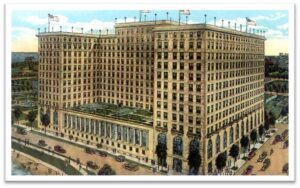17 Part One: Encounter
Part One: Encounter
Chapter 2. This second flashback showcases Larsen’s Modernist descriptive technique. The scene is vivid without being especially detailed or concrete. Larsen combines objective and subjective description, inner and outer states:
With the sun beating down ‘like molten rain’… the cityscape turns into an indeterminate slush. Surfaces appear to melt away from flaccid buildings as dust whips up, ‘stinging the seared or dripping skins of wilting pedestrians.’ Buildings ‘shudder’ and ‘quiver’ in ways analogous to bodies, while skins ‘sear’ and ‘drip’ in the fashion of melted materials. In this blurry scene, surfaces oscillate, deflecting interpretation and refusing to stand in as firm markers or stable boundaries. (Brown 108)
If you compare the opening paragraphs of this chapter to the panoramic description of San Francisco’s Polk Street in chapter 1 of McTeague, you will see the difference in representational modes. Using the window as a frame, Norris gave his readers a distant view of the different types of people in the city street. Likewise, this chapter from Passing is concerned with visual perception, but it is not interested in objective classifications. Instead, it draws our attention to the limits of visual perception: What can a person see from the rooftop that she cannot see from street level? When does the light of day obscure things rather than bring them into view? These questions will recur throughout the novel.
A man is on the sidewalk, dead or unconscious. Irene does not know what is going on, and she does not want to know. A picture is emerging of a character who needs to maintain firm boundaries, physical and otherwise. But the hot, crowded city has made that impossible. Irene is “soiled from contact with so many sweating bodies.”
There is no mention of race until Irene spots the woman on the roof of the Drayton Hotel without yet recognizing her as Clare. From this point, the ironies accumulate quickly: Irene assumes the woman is white, and that as a white person, she must be “stupid” enough to think she could discern someone else’s (Irene’s) race based on physical details. But of course Clare is not white, and Irene is the one anatomizing her. We see how Irene’s experience of race is interwoven with an experience of class: Were Irene to be exposed as black at the Drayton, she expects she would be expelled in a “polite and tactful way.” There is an implicit contrast with the blatant racism of the Deep South. Race does not come up in the women’s strained conversation, either, although it is present as a subtext in the rumours Irene had heard about Clare working as a prostitute.
Pay attention to the way Clare describes her mixed-race upbringing. Her determination “to be a person and not a charity or a problem” is probably a deliberate echo of Du Bois’s The Souls of Black Folk:
Between me and the other world there is ever an unasked question: unasked by some through feelings of delicacy; by others through the difficulty of rightly framing it. All, nevertheless, flutter round it. They approach me in a half-hesitant sort of way, eye me curiously or compassionately, and then, instead of saying directly, How does it feel to be a problem? they say, I know an excellent colored man in my town; or, I fought at Mechanicsville; or, Do not these Southern outrages make your blood boil? At these I smile, or am interested, or reduce the boiling to a simmer, as the occasion may require. To the real question, How does it feel to be a problem? I answer seldom a word. (Du Bois 1)


